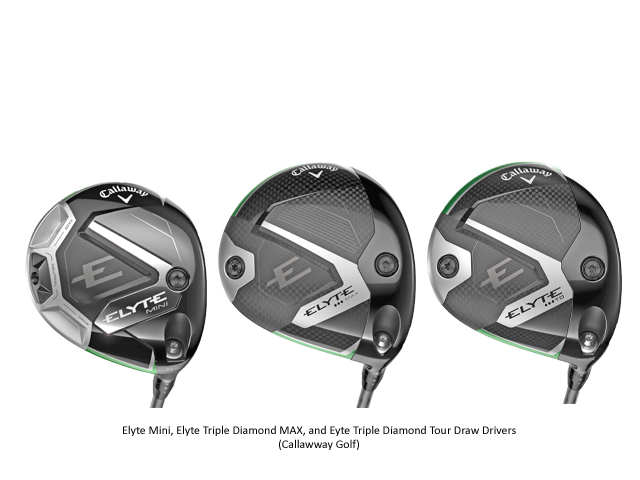By ED TRAVIS
Adding to the Elyte family of drivers announced in Jan., Callaway Golf has brought out three new models, the Elyte Mini, Elyte Triple Damond MAX and Elyte Triple Diamond Tour Draw.
Fast Facts
Callaway Elyte Mini Driver
Better player category
340 cc clubhead
Ai10x Face variable thickness
Carbon fiber crown
Three position skirt weight
11.5° or 13.5° loft
Adjustable hosel
Stock shaft: True Temper Project X Denali
Shaft length: 43.75”
Stock grip: Golf Pride Tour Velvet
At retail April 4
$450
Callaway Elyte Triple Diamond MAX
Better player category
460 cc clubhead
Ai10x Face variable thickness
Carbon fiber crown
9° or 10.5° loft
Adjustable hosel
Stock shafts: Aretera EC1 Blue, Mitsubishi Tensei 1K
Shaft length: 45.75”
Stock grip: Golf Pride Tour Velvet
At retail April 4
$650
Elyte Triple Diamond Tour Draw
Better player category
450 cc clubhead
Ai10x Face variable thickness
Carbon fiber crown
9° or 10.5° loft
Adjustable hosel
Stock shafts: Aretera EC1 Blue, Mitsubishi Tensei 1K
Shaft length: 45.75”
Stock grip: Golf Pride Tour Velvet
At retail April 4
$650
WYNTK
The family of Elyte drivers introduced in Jan. by Callaway featured several improvements including reshaping of the heads for less aerodynamic drag on the downswing, a new Ai-designed variable thickness face and an improved carbon fiber crown, all of which were carried on to the three latest members of the family.
The Elyte Mini capitalizes on the interest shown by pros and better amateurs for a shorter length driver with a smaller head that will serve as a “fairway-finder” plus the new Mini has a rear weight that can be adjusted to help produce a neutral, draw or fade tendency for the ball.
Designed for tour professionals, the Elyte Triple Diamond MAX is a combination of the Elyte Triple Diamond and Elyte standard drivers but with more forgiveness than the original Triple Diamond.
Having a slightly more compact head shape than the Elyte Triple Diamond, the Elyte Triple Diamond Tour Draw also has weighting towards the heel to facilitate right to left ball for pros wanting a stronger draw bias.

